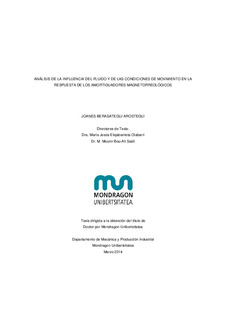
Ikusi/
Izenburua
Análisis de la influencia del fluido y de las condiciones de movimiento en la respuesta de los amortiguadores magnetoreológicosEgilea
Irakurtze Data
2014-06-19Argitalpen data
2014Dokumentu-mota
Doktore tesiaDoktore tesiaHizkuntza
GaztelaniaEskubideak
© Joanes Berasategui ArosteguiSarbidea
Sarbide irekiaArgitaratzailearen bertsioa
https://doi.org/10.48764/3g7y-jt39Argitaratzailea
Mondragon Unibertsitatea. Goi Eskola PoliteknikoaGako-hitzak
Ingeniería y tecnología mecánicasPropiedades mecánicas de los solidos
Laburpena
In this thesis the magneto-hydro-dynamic behaviour of magneto-rheological (MR) dampers has been analysed taking into account the damper design, the inner fluid and the applied movement conditions. The ... [+]
In this thesis the magneto-hydro-dynamic behaviour of magneto-rheological (MR) dampers has been analysed taking into account the damper design, the inner fluid and the applied movement conditions. The thesis is divided in six chapters: Introduction; formulation of MR fluids; Magnetorheological characterization of MR fluids; Design of MR dampers; Magneto-hydro-dynamic analysis of MR dampers; and Conclusions.
MR fluids with different compositions have been formulated. The concentrations of the additives have been determined to obtain stable fluids. All the aspects referring the production of these fluids are gathered in the second chapter of this document.
The rheological behaviour of MR fluids has been characterized by two types of tests, shear rate sweeps and strain sweeps, both under a magnetic field. The obtained results have allowed developing a new rheological model for the pre-yield regime of MR fluids. The post-yield regime has been described with the Herschel-Bulkley model.
In the chapter referring the design of MR dampers, on the one hand, the design and manufacture of two MR damper with different flow modes (valve and mixed) are described. On the other hand, the theoretical analysis of the magneto-hydro-dynamic behaviour of both dampers is described. In this study the theoretical damping force of both MR dampers have been established taking into account the geometry, the magnetic circuit and the rheological behaviour of MR fluids.
The magneto-hydro-dynamic behaviour or MR dampers has been analysed according to the rheological behaviour of MR fluids, to the flow mode and to the applied type of movement. This analysis has been performed experimentally and theoretically. The obtained results have shown that the magneto-hydro-dynamic behaviour of MR dampers is determined by the applied type of movements and by the rheological behaviour of inner fluid, but is independent of the flow mode of the MR fluid. [-]
Tesi honetan motelgailu magneto-erreologikoen (MR) portaera magneto-hidro-dinamikoa aztertzen da bere diseinua, fluidoa eta ezarritako mugimendu baldintzak aintzat hartuz. Tesi hau sei kapitulutan ban ... [+]
Tesi honetan motelgailu magneto-erreologikoen (MR) portaera magneto-hidro-dinamikoa aztertzen da bere diseinua, fluidoa eta ezarritako mugimendu baldintzak aintzat hartuz. Tesi hau sei kapitulutan banatzen da: Sarrera; Fluido MR-en formulazioa; Fluido MR-en karakterizazioa; Motelgailu MR-en diseinua; Motelgailu MR-en portaera magneto-hidro-dinamikoa; eta Ondorioak.
Osaketa ezberdineko fluido MR-ak formulatu dira. Erabilitako gehigarrien kontzentrazioek formulatutako fluidoen egonkortasuna bermatu dute. Fluido hauen garapenean parte hartzen duten aspektuak dokumentu honen bigarren kapituluan biltzen dira.
Fluido MR-en portaera bi entsegu motekin karakterizatu da, deformazio eta deformazio abiadura ekortzeak, biak eremu magnetikopean. Lortutako emaitzen analisiak eredu erreologiko berri baten garapena ahalbidetu du fluidoen ebakidura-atalase aurretiko portaera azaltzeko. Ebakidura atalase ondorengo portaera Herschel-Bulkley ereduaren arabera deskribatu da.
Motelgailu MR-en diseinua aztertzen den kapituluan, alde batetik bi motelgailu ezberdinen diseinua eta ekoizpena deskribatzen da. Motelgailu hauek fluidoaren bi lan modu ezberdin ezartzen dituzte: balbula eta mistoa. Beste alde batetik, motelgailu hauen portaera magneto-hido-dinamiko teorikoa aztertu da. Analisi honetan bi motelgailuen indar teorikoa ezarri da hauen geometria, zirkuitu magnetikoa eta fluidoaren portaera erreologikoa kontutan hartuz.
Azkenik, motelgailu MR-en portaera magneto-hidro-dinamikoa aztertu da fluido magnetikoa, honen lan modua eta ezarritako mugimendua aintzat hatuz. Analisi hau modu esperimental zein teorikoan burutu da. Lortutako emaitzek erakutsi dute motelgailu MR-en portaera magneto-hidro-dinamikoa ezarritako mugimenduaren eta erabilitako fluidoaren araberako dela, eta ez fluidoaren lan moduaren araberakoa. [-]
En esta tesis doctoral se resume la investigación realizada sobre el comportamiento magneto-hidrodinámico de amortiguadores magnetorreológicos (MR) en base al diseño, al fluido, y a las condiciones de ... [+]
En esta tesis doctoral se resume la investigación realizada sobre el comportamiento magneto-hidrodinámico de amortiguadores magnetorreológicos (MR) en base al diseño, al fluido, y a las condiciones de movimiento que se les impone. La tesis está dividida en seis capítulos: Introducción; Formulación de fluidos MR; Caracterización magnetorreológica de fluidos MR; Diseño de amortiguadores MR; Análisis del comportamiento magneto-hidro-dinámico de amortiguadores MR; y Conclusiones.
Se han formulado fluidos MR con diferentes composiciones. La concentración de los aditivos utilizados en la formulación garantiza la estabilidad coloidal de los fluidos sintetizados. Todos los aspectos relacionados con la elaboración de estos fluidos se recogen en el segundo capítulo de este documento.
El comportamiento de los fluidos MR se ha caracterizado con dos tipos de ensayos, barridos de velocidad de deformación y barridos de deformación, ambos bajo campo magnético. El análisis de los resultados obtenidos ha permitido desarrollar un nuevo modelo magnetorreológico para el régimen pre-umbral, quedando el post-umbral descrito por el modelo de Herschel-Bulkley.
En el capítulo de diseño de amortiguadores MR se describe por un lado, el diseño y la fabricación de dos prototipos de amortiguadores MR con diferente modo de trabajo: válvula y mixto, y por otro, el estudio teórico del comportamiento magneto-hidro-dinámico de ambos. En este estudio se ha determinado la fuerza de amortiguamiento teórica de los dos prototipos de amortiguadores de acuerdo con la geometría, el circuito magnético y el comportamiento reológico de los fluidos MR.
El comportamiento magneto-hidro-dinámico de los amortiguadores MR se ha analizado en función de la reología de los fluidos MR y de su modo de trabajo, así como del movimiento aplicado al amortiguador. Este análisis se ha realizado tanto experimental, como teóricamente. Los resultados obtenidos muestran que el comportamiento magneto-hidro-dinámico de los amortiguadores MR depende del tipo de movimiento al que está sometido y del fluido que contiene, pero es independiente del modo en que trabaja el fluido MR. [-]
Bildumak
- Tesiak - Ingeniaritza [243]




















